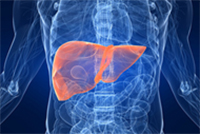Radiant beads fighting liver cancer

Like a swarm of diving robots, tiny beads of synthetic resin flow through the patient's blood. Only about one-third as wide as a human hair, the roughly 30 micron size balls easily transit the flexible plastic tube that guides them through the hepatic artery. Their goal: the tumor in the patient's liver. Their payload: the radiolucent element Yttrium-90.
Once in the liver, the radioactively tagged microspheres are distributed through ever more finely branched blood vessels. Finally, they become stuck in the tiny blood capillaries and fulfill their dual mission. First, with their radiation they destroy the tumor tissue in their immediate vicinity. Second, they block the blood vessels and thus cut off the tumor from its supply of nutrients. The healthy part of the liver is well protected from the radiating globules: about 80 percent of its blood comes from the portal vein, whereas liver tumors and metastases depend on the branching hepatic artery.
Stopping the tumor
"In the best case, so many of the starved and irradiated tumor cells die that the patient can later be operated on and freed from the rest of the tumor tissue," says Dr. Lars Maruschke, Senior Physician and head of the Interventional Radiology section at the Medical Center - University of Freiburg. "But even if we only cause the tumor to stop growing or to slow its rate of growth, we can improve both quality of life and life expectancy with this treatment."
Selective internal radiotherapy (SIRT) is an advanced treatment method in which radiologists and nuclear medicine specialists are equally involved. It is recommended in certain cases after thorough consultation in the "Gastrointestinal Tumors" or "Liver Tumors" boards at the Comprehensive Cancer Center Freiburg - CCCF, if liver tumors or metastases cannot be operated on due to their size, number or location, nor be treated by other procedures such as radiofrequency or microwave ablation.
Microspheres arrive safely on target
In order for the microspheres to arrive at the right place, the radiologists, at a preparatory appointment, examine the patient's tumor-supplying liver arteries with the aid of contrast agents and X-rays. Any existing diverging branches to the gallbladder, duodenum or stomach are closed with small platinum coils, if necessary. This avoids unwanted placement of microspheres in these organs, while other blood vessels continue to ensure their supply. Subsequently, in a simulation of the later procedure, specially tagged, degradable protein particles are injected into the hepatic artery and their distribution is examined by means of nuclear-medical computed tomography.
Irradiated from within
Only when it has been ensured that the microspheres will later really only stay in the liver, and that too much radiation will not reach the lungs, do the nuclear medicine specialists send the radioactive beads on their journey into the tumor tissue. The radiation dose administered can be determined exactly by the amount of beads. Radiologists and nuclear medicine specialists specify this for each patient individually. "Since the radiation range of Yttrium-90 in human tissue extends only a few millimeters, we can achieve significantly higher doses compared to external radiation, without damaging the healthy liver tissue," explains Professor Dr. Dr. Philipp T. Meyer, Medical Director of the Department of Nuclear Medicine at the Medical Center - University of Freiburg.
After their SIRT treatment, patients receive continuous support: "Despite the low level of outgoing radiation, we bring patients into our ward for 48 hours on radiation protection grounds and for medical monitoring," adds Professor Dr. Juri Ruf, Senior Consultant in the Department of Nuclear Medicine, with a focus on oncological diagnostics and treatment.
Patients quickly return to daily life
"Compared to many chemotherapies, the side effects of SIRT are quite manageable," says Professor Dr. Fabian Bamberg, Medical Director of the Department of Radiology at the Medical Center - University of Freiburg. "Although abdominal pain, nausea, mild fever and fatigue may occur shortly following treatment, after a few days most patients can go home and very soon return to their normal activities."
Back